MAL ROGERS risks square eyes by assessing the films that put the Emerald Isle on the silver screen
SOMETIMES dramatic, sometimes mellow, Ireland’s landscape has provided the backdrop to a huge range of films ranging from the gentle paddywhackeray of The Quiet Man to the gritty reality of Calvary.
From Man of Aran (1934) to The Banshees of Inisherin (2022), the islands, highlands, glens, beaches and moorland of almost every Irish county have stood in for backdrops to fantasy films, war movies, historical dramas, whimsical stories, psychological thrillers.
The formidable crags of Co. Galway have played host to the Saxon hordes in Alfred the Great; the Wicklow Hills have seen Henry V's army march by (played by members of the Irish Defence Forces in their first big movie break) and the Causeway Coastal Route has watched as Lannisters, Daenerys Targaryen or the Baratheons carried out their bloodletting in Game of Thrones. The staggeringly formidable Dunluce Castle was perfect for the HBO series, while the almost impossibly picturesque Ballintoy Harbour, with its limestone and basalt cliffs rising vertically out of the sea, could scarcely have been bettered for the location where Theon arrives on Dragonstone. From here you'll get terrific views across jet black rocks to Sheep Island (real name, not a GofT makey-up one). Britain, only 12 miles away, is also visible, looking like a slightly bigger Sheep Island.
As far as film-making is concerned, Ireland is now a major player - it has the scenery, the actors, the technicians, the extras. In short, Ireland is box office. For goodness sake, even the lion which roars at the beginning of all MGM films was born in The Phoenix Park in Dublin.
Here we look back at seven of the more notable films and their locations spanning the last seventy years
Moby Dick (1956)
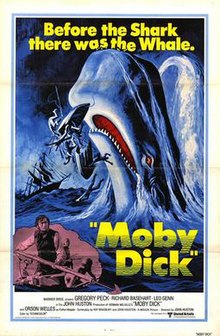 Moby Dick film poster (Wikipedia)
Moby Dick film poster (Wikipedia)The Scottish writer Claud Cockburn, who lived in Youghal for most of his adult life, always described the place as 'standing at a slight angle to the universe'. While this quirkiness probably had some bearing on director John Huston's decision to film the 1956 production of Moby Dick, starring Gregory Peck and Orson Welles, in the Co. Cork seaside town, there were probably a few other reasons as well. And they're probably the same reasons which almost fifty years later continue to take production companies to the country: a highly skilled film work force, lower production costs than in Britain or America, generous grants and incentives. fact that Ireland is a film-friendly country also helped. (Per capita, Ireland has one of the biggest cinema-going populations in Europe)
When filming Moby Dick Huston made expert use of Cork's photogenic coastal scenery — in an area which very fittingly today is a haven for whale watchers. He also availed himself of the 'local' talent: Dublin actor Noel Purcell, Belfast man Joseph Tomelty, as well as Edric Connor and Seamus Kelly. Now here's a supreme piece of trivia. Leo Genn acted the part of the first mate, Starbuck, a man who was inordinately fond of coffee. And yes, you've guessed it. That's where Starbuck's coffee stores got their name.
Star Wars
Skellig Michael – and neighbouring Little Skellig – have featured in ancient Irish legends, have loomed large in Ireland’s religious story, and were even visited by Vikings. But it wasn’t until 2014 that these remote peaks welcomed their strangest visitor so far: one of the biggest movie-making phenomena in history, Star Wars. Luke Skywalker, C-3PO, Obi-Wan Kenobi and all the gang, accompanied by cast, crew, Jedi and Droids, fetched up on the rocky island to film Star Wars Episode VIII — The Force Awakens. The filming took place on Skellig Michael, Iceland, Greenham Common in England and Abu Dhabi. And it’s not often you get those four places bracketed together.
The t-shirts predictably went on sale, proclaiming, “May the craic be with you”, but the Office of Public Works quickly decided to reduce the craic, and cracked down on the number of visitors allowed to land on the islands that rise improbably from the Atlantic, one of the highlights of Ireland's Wild Atlantic Way.
The Quiet Man (1952)
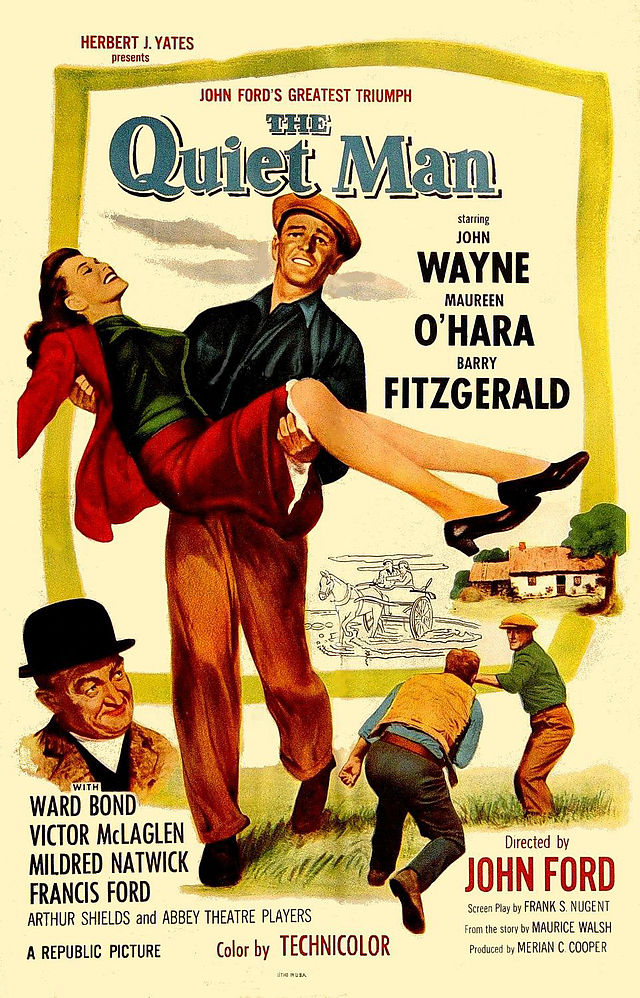 The Quiet Man (picture in public domain)
The Quiet Man (picture in public domain)“Now, I'll begin at the beginnin'. A fine soft day in the spring it was when the train pulled into Castletown three hours late as usual, and himself got off. He didn't have the look of an American tourist at all about him. Not a camera on him. And what was worse, not even a fishing rod.”
Yep, The Quiet Man. The quintessentially Irish pastoral countryside of Mayo becomes the backdrop for Hollywood's finest paddywhackery, and seventy years later avid film buffs and movie-tourists continue to make pilgrimages to the area.
Director John Ford (born John Feeney or O'Feeney) claimed that he gleaned some of his background information on Ireland from a source that could hardly be less tainted with paddywhackery: Michael Collins. By coincidence, John Ford crossed to Ireland on the same boat that brought Michael Collins home from the Treaty negotiations in London. Ford said that he had a long and instructive conversation with Collins.
Ryan’s Daughter (1970)
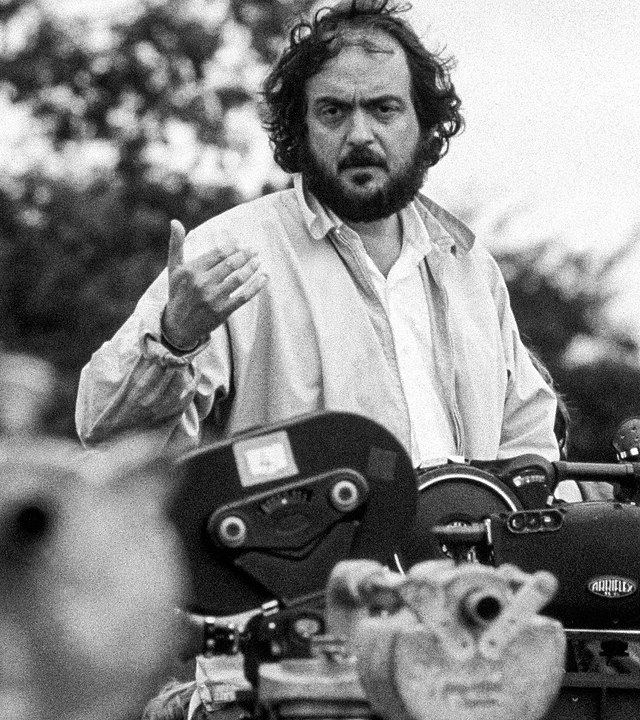 Stanley Kubrick on the set of Barry Lyndon (picture in public domain)
Stanley Kubrick on the set of Barry Lyndon (picture in public domain)Ryan's Daughter probably scoops the award for one of the most resounding images in Ireland's cinematic history — the crashing of waves on the beach in the David Lean film. Today, you can follow the signs on Dingle Peninsula to Ryan's Daughter Beach aka Coumeenoole Strand. For the film an entire village was recreated among the patchwork of fields near Dunquin, and dismantled when filming was over. Almost a quarter of a century later, another village was constructed, close to the original location overlooking the Atlantic Ocean, for the Tom Cruise/ Nicole Kidman version of Far and Away.
Saving Private Ryan (1998)
Saving Private Ryan filmed on the sands of Curracloe Beach, saw Co. Wexford masquerading as Normandy and Irish squaddies from the Defence Forces this time playing the part of GIs.
Spielberg’s epic war film, set in France in 1944, became the second-highest-grossing film of 1998. It went on to win a bucketload of accolades, including Golden Globe, Academy, BAFTA, and Saturn awards.
Saving Private Ryan is considered one of the finest movies ever made, with its filming techniques for battle scenes influencing many subsequent war, action, and superhero films.
Curracloe Beach also emerged from the film with credit, and in 2015 was the location for scenes from Brooklyn, featuring Saoirse Ronan.
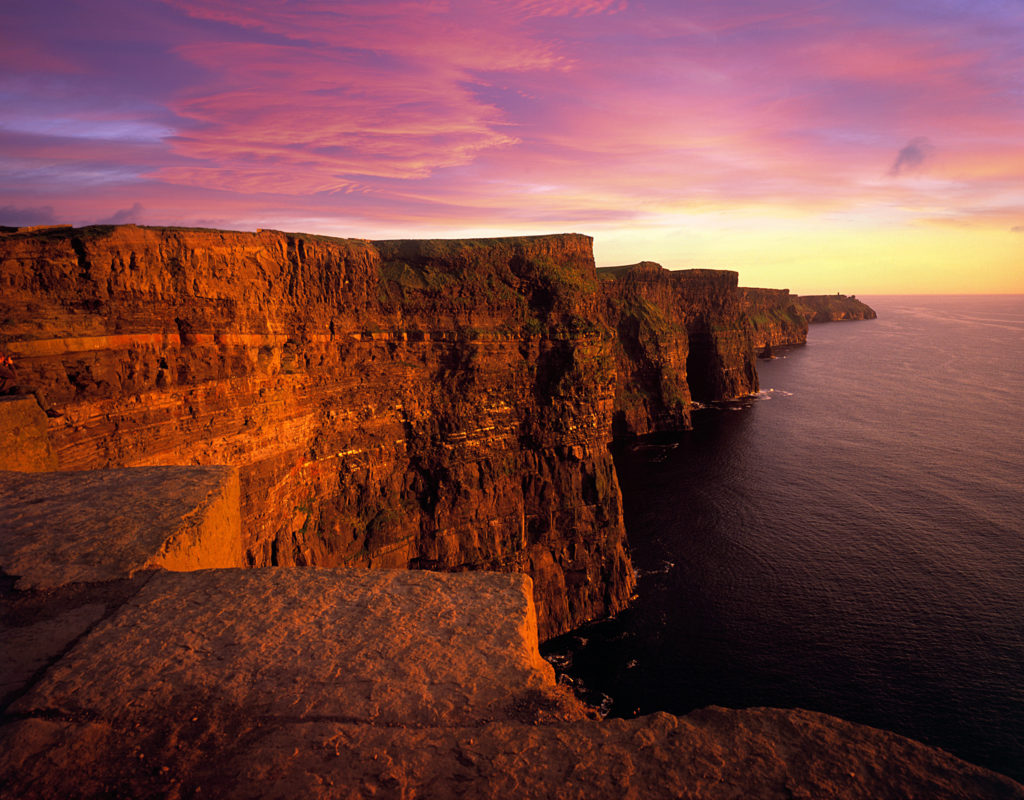 Cliffs of Moher, Co. Clare (photo Tourism Ireland)
Cliffs of Moher, Co. Clare (photo Tourism Ireland)Harry Potter and the Half-Blood Prince
The sixth Harry Potter film features the Cliffs of Moher. It is in the frame when Harry joins Professor Dumbledore (played by the sadly departed Dublin actor Michael Gambon) to seek out the third Horcrux needed to destroy Lord Voldemort.
The two stand on a steep, sloping rock with waves crashing and swirling around them. As they are pounded by the Atlantic, they turn to face an imposing wall of cliffs with a cave at the centre. These are, of course, the Cliffs of Moher where the Old World, Europe and the EU come to an abrupt stop. Lemon Rock, on which the pair stand is actually further down the Wild Atlantic Way, off the Iveragh Peninsula in Co. Kerry.
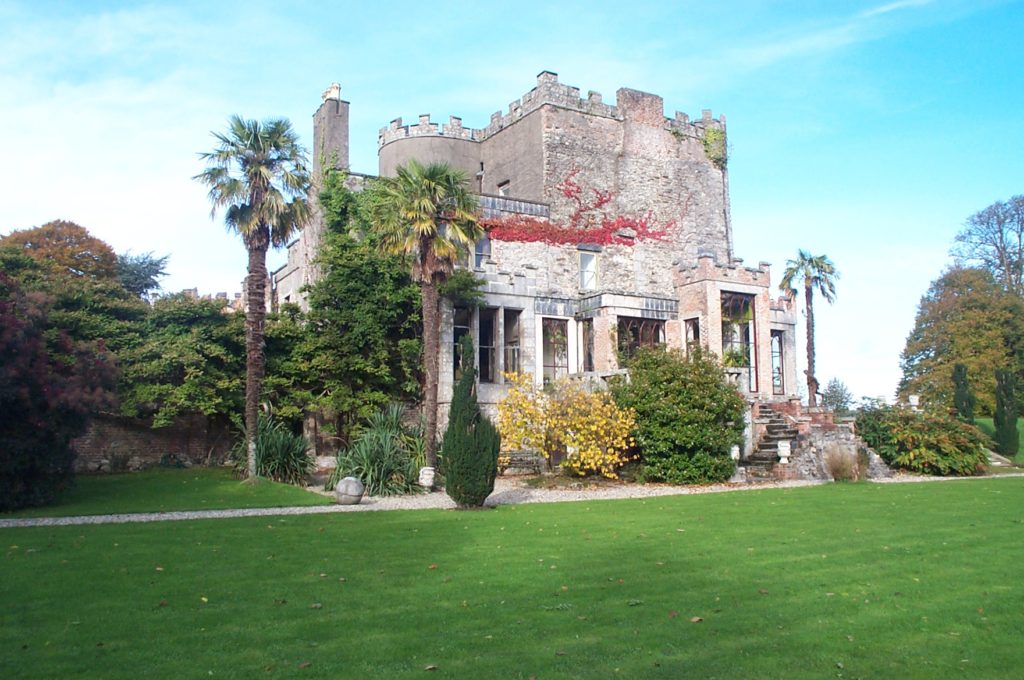 Huntington Castle
Huntington CastleBarry Lyndon (1975)
Barry Lyndon is a 1975 historical drama film written, directed, and produced by Stanley Kubrick Starring Ryan O'Neal, Marisa Berenson, Patrick Magee, Leonard Rossiter, and Hardy Krüger, the film recounts the exploits of a fictional 18th-century Irish soldier-adventurer-gambler-playboy-con-man created by English novelist William Makepeace Thackeray.
Several of the interior scenes were filmed in Powerscourt House, the 18th-century mansion in Co. Wicklow. The house was destroyed in an accidental fire several months after filming (November 1974), so the movie serves as a valuable record of the lost interiors.
The endlessly fascinating Huntington Castle, Clonegal, Co. Carlow is also featured, as well as Waterford Castle (now a luxury hotel and golf course) and Little Island, Waterford. Locations also included Moorstown Castle in Tipperary, Castletown House in Celbridge, Co. Kildare, outside Carrick-on-Suir, Co. Tipperary, and at Youghal, Co. Cork.
The filming took place against the backdrop of some of the worst years of the Troubles. One day a phone call was received and Kubrick was given 24 hours by the IRA to leave the country; he left within 12 hours. According to various accounts, including biographies, the IRA had placed the director on a “hit list,” apparently because the film was depicting English soldiers on Irish soil.
Whether a hoax or real, Stanley was not willing to take the risk. He packed his bag and legged it. It was rumoured that the film would be abandoned, but in the end it was completed at locations far away from Ireland’s shores. But enough had been filmed in the country so that none of thr grandeur of the scenery was lost.
The theme music and much of the incidental music was provided by The Chieftains. Their treatment of Mná na hÉireann (Women of Ireland) written by Seán ÓRiada, gave their career a huge leg-up
In the 2022 Sight & Sound Greatest Films of All Time poll, Barry Lyndon placed 12th in the directors' poll and 45th in the critics' poll.

